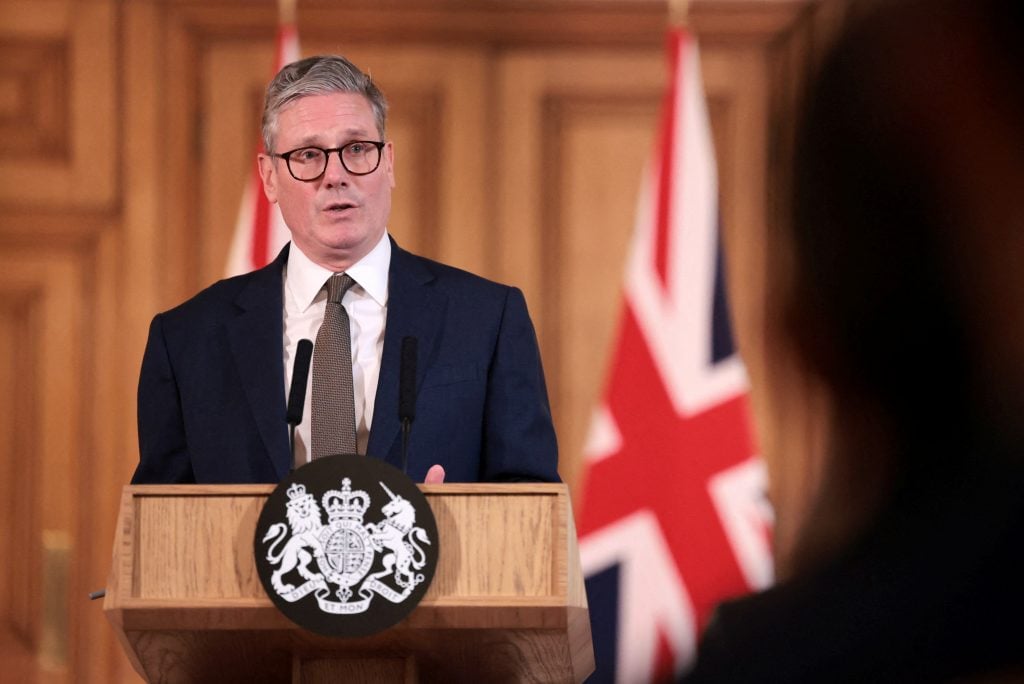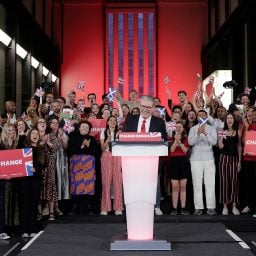It was a big photo-op moment when the U.K.’s new prime minister Keir Starmer delivered his victory speech at Tate Modern last Friday after leading the Labour party to a historic landslide win in the general election. Standing against the red-lit backdrop of the Turbine Hall, illuminated to match the signature color of the winning party, Starmer said “it feels good” to a cheering crowd, and pledged to “restore Britain to the service of working people.”
Labour’s win was predicted, especially as public anger has mounted against the austerity-fueled policies of the Conservative “Tory” party over the last several years. Yet Starmer’s unstoppable momentum has not assured many in the arts and culture sector. Some industry professionals, from institution leaders to advisors and critics, remain skeptical that the new government will be able to rectify the “chaos” inflicted on the cultural sector under 14 years of Tory rule, as Labour has pledged to do in their manifesto. Moreover, it seems that some Labour policies may cause even further financial strain for the art trade.
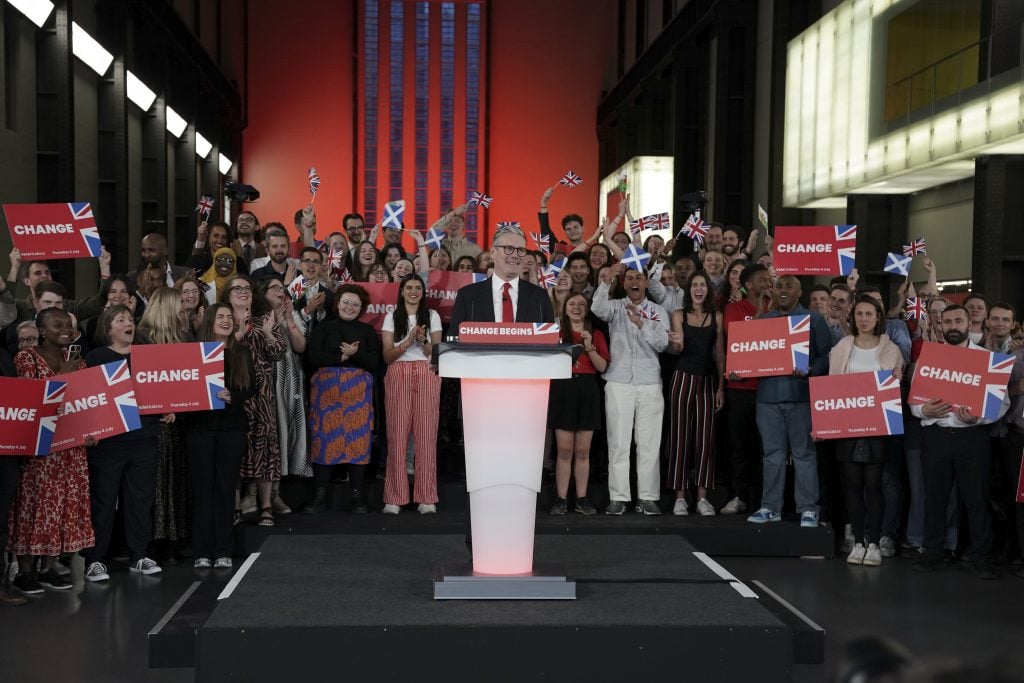
Keir Starmer delivers a victory speech to supporters at Tate Modern on July 4. Photo: Jeff Moore/PA Images via Getty Images.
Installing a consistent and competent culture secretary, Lisa Nandy, has necessarily been Labour’s first order of business. Besides ruthlessly slashing arts funding, the Tories were also criticized for destabilizing the culture sector thanks to a constant churn of culture secretaries—12 within 14 years. Yet there has already been some upheaval among Labour in the same field. Thangam Debbonaire, the former Shadow Secretary of State for Culture, Media, and Sport, who oversaw the Labour party’s 33-page arts and culture sector plan announced in March, lost her MP seat in Bristol to the Green Party.
The party has subsequently appointed the 44-year-old Nandy to take up the culture secretary job, and she faces the monumental task of catching up on months of prep work in the matter of a few days since other shadow secretaries who are assuming their seats will have been readying themselves since the beginning of the year. She will work with Chris Bryant, who was Labour’s shadow minister for the arts for nine months in 2015, and has now been named minister of state for the Department of Culture, Media, and Sport. He has also been appointed minister in the Department for Science, Technology, and Innovation.
The “era of culture wars is over”, Nandy proclaimed in her first speech as culture secretary, saying her department will endeavor to reflect a more positive and less divisive vision of the U.K.
New Priorities?
Yet neither Nandy nor Bryant have a background in the arts. (Debbonaire, for her part, is a classically trained cellist.) Both have been more focused on media in their careers: Nandy has written on reforming the BBC while Bryant, a former Anglican priest, worked at the BBC from 1998 until he was elected to parliament in 2001. In a department that encompasses such a broad interpretation of culture, it remains to be seen whether they will prioritize the arts in their very long list of to-dos.
Indeed, since before the election, the low priority of arts and culture in the party’s manifesto and conflicting policies on tax and economy have also worried industry players.
“Apart from a few positive rumblings here and there, and holding a victory speech at Tate Modern, I have seen no firm commitments,” noted Leslie Ramos, co-founder of art philanthropy advisory firm The Twentieth, and author of Philanthropy in the Arts: A Game of Give and Take, in an email to Artnet News.
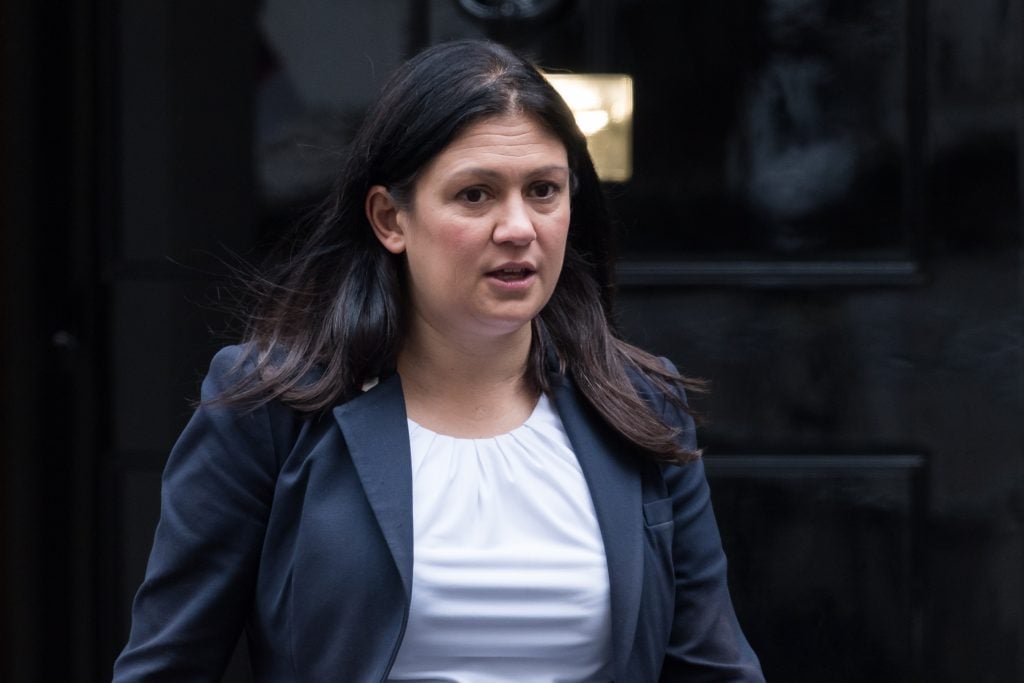
Secretary of State for Culture, Media and Sport Lisa Nandy leaves Downing Street after attending Cabinet meeting on July 9. Photo: Wiktor Szymanowicz/Future Publishing via Getty Images.
Labour has pledged to review many areas of the sector such as education and public access to art, and step up the protection of art workers, but the major headache for the sector is money. The arts and culture sector has been struggling under Tory rule, which has made a series of deep funding cuts since the party came to power in 2010. Meanwhile, several local councils have gone bust one after another in recent years, crying for reform. Immediately after the election last week, Tristram Hunt, director of London’s Victoria and Albert Museum, called for “emergency financial support for regional museums facing bankruptcy.”
Many hope that Labour can implement change quickly. The party’s culture sector plan recognized the economic contribution from the creative sector and the money issue but did not promise more state funding. Instead, it said that it will work with funding bodies, public funders, investors, and donors “to create a private finance model or models to attract more funding from different sources into arts organizations.” It added that a spending review of the Arts Council England, the foremost public funding body in the U.K., will go ahead; it was already earmarked for review this year under the previous Conservative government.
“We anticipate the new government will conduct a Spending Review sooner rather than later,” Darren Henley, CEO of Arts Council England, wrote on the council’s blog reflecting on the general election. While noting that the council is ready to provide support, Henley also recognized the reality of the country’s economic difficulties and “severe pressures on the public purse,” it is not a handout that the sector is after. “Our sector needs investment,” he said.
The Department of Culture, Media, and Sport did not respond to a request for comment on when the review would begin or the timeline for the implementation of other funding models.
“The truth is they have no money, and the U.K.’s productivity is shot. The government has bigger priorities than the arts, as much as that pains me to say,” Ramos noted, adding that the country should reform the philanthropy entities, such as Gift Aid and charities systems, so that resources can be spent more efficiently.
Ongoing Wealth Drain
The prospect of institutions’ increasing reliance on funding from the private sector, patrons, and donors, many of who are also major supporters of the art market, has drawn concerns from industry professionals. The turbulent years post-Brexit already saw an exodus of 16,500 millionaires, and this is likely to worsen in 2024, according to Henley Private Wealth Management’s report, released last month. It projected that 9,500 millionaires will be leaving the U.K. before the year is out, doubling 2023’s figure and marking the second highest millionaire outflow after China (which is a much larger country).
Although Labour has pledged not to increase income tax, national insurance, or value-added tax, the party has vowed to close the tax gap with a “£15 billion tax raid” cracking down on tax dodgers. Areas including pensions, capital gain tax, and inheritance are easy targets. The reform of tax policies to make “non-dom” residents (residents in Britain who declare “domicile” outside the country) pay U.K. tax on income generated overseas has already scared some wealthy individuals away. Media outlets from across the spectrum, from the Financial Times to Daily Mail, have been publishing tips and guides advising people how to escape from the Labour tax raids since the election.
“I know it is difficult to sympathize with the wealthy, but the combination of Brexit and the repeal of non-dom status has made the U.K. less appealing to a certain level of internationalized arts supporters,” Ramos pointed out.
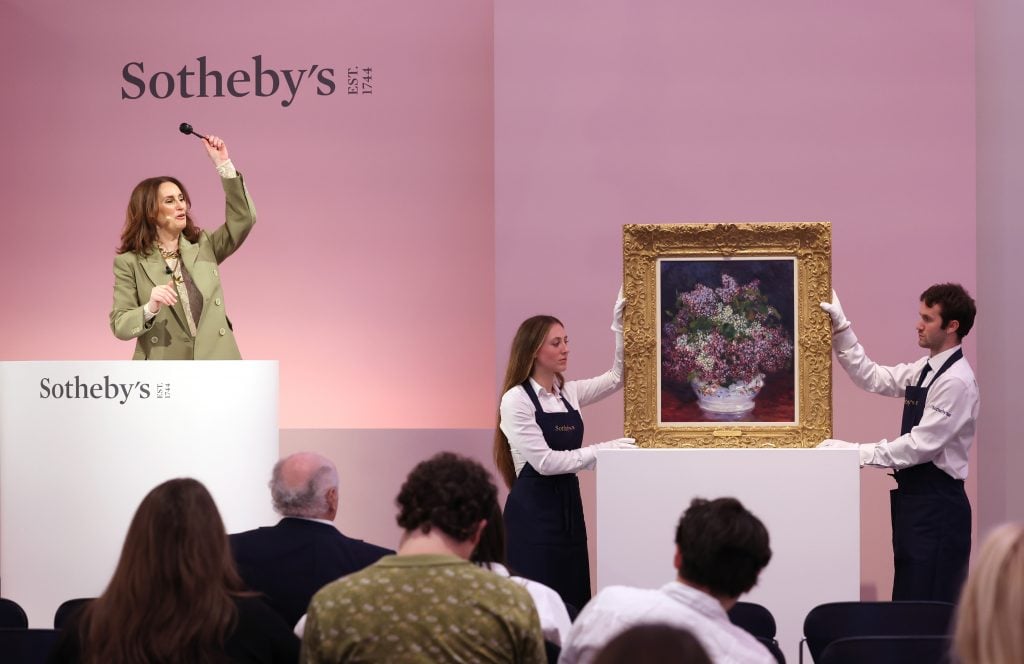
Helena Newman, auctioneering Pierre-Auguste Renoir’s Bouquet de lilas at Sotheby’s Evening Auction, including the Ralph I. Goldenberg Collection, London, June 2024. Image courtesy of Sotheby’s.
Arts patrons and donors have been eyeing the exit or holding off significant philanthropic investment plans in the U.K., Ramos added. “They are moving to Italy, to Spain, to Switzerland, all over. They might keep supporting one or two things in the U.K. at a low level, probably in London, but their main support will go elsewhere,” she said.
For far too long, High-Net-Worth Individuals (HNWIs), patrons, and institutions have “received conflicting messages,” according to Aaron Cezar, the director of the London-based nonprofit Delfina Foundation. “Labour (and the Tories before them) want to foster a culture of philanthropy but there are few incentives in place—and those that exist are confusing or restrictive.”
Cezar revealed that some non-doms he knew would consider leaving or give less to the arts should they stay, as they would expect increased tax payments would be funneled into the arts eventually. Tax benefits aside, donors, including the international ones, need to see that their efforts in supporting the arts in the country are appreciated and valued, he noted. Brexit is also regarded by many European patrons as “a vote against them and their contributions.”
“People also give for status, but if they see the government allowing institutions to be run into the ground, with overworked staff in crumbling buildings, why should they step in if the government doesn’t hold these institutions in high regard,” Cezar noted.
Business Busts
Art dealers, auction houses, and fair and event organizers have also been adjusting to the post-Brexit business landscape and the ensuing exodus of HNWIs. Last year, MCH Group canceled Masterpiece fair citing escalating costs and fewer international exhibitors. Christie’s, despite being headquartered in London, canceled its usual June Modern and contemporary art evening auction this year, while Sotheby’s recent evening sale total was down by half from last year. Sotheby’s is also eyeing on job cuts, with its U.K. headquarters being the most affected.
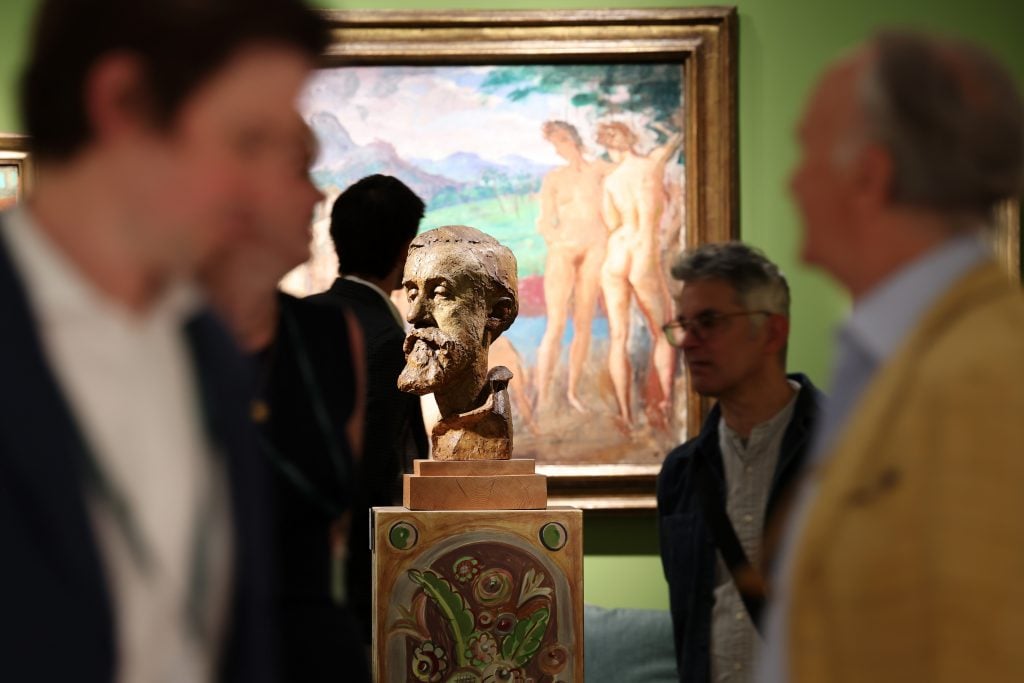
Philip Mould & Company’s Immersive booth infused with a Bloomsbury Group aesthetic by interior designer Edward Bulmer at the opening of The Treasure House Fair on June 27. The fair was launched last year following the abrupt cancelation of Masterpiece. Photo: Tristan Fewings/Getty Images for The Treasure House Fair.
Nevertheless, the U.K. is still the third largest art market globally, behind the U.S. and China, and industry representatives have been lobbying for easing the red-tape for art imports and exports after Brexit made it more challenging to bring art to sell in the U.K. Earlier this year, the U.K. Treasury conducted a consultation on temporary admission, a mechanism that waives value-added tax (VAT) on imported artworks unless they are sold to a U.K.-based buyer and remain in the U.K. The industry body the British Art Market Federation, which conducted a market survey last year, also raised the issues to the Labour Party before the general election and received supportive response.
“We have been working with the government on a number of areas with a view to reducing the burden of administration upon art businesses,” noted Martin Wilson, chairman of the British Art Market Federation, adding that he hopes the new government will continue with the work.
Wilson said he believes there is no reason to think that arts and culture will not be a high priority for Labour. “We think that the new government will be aware of the significant contribution of the art market in terms of employment, tourism, fiscal revenue, and our image as a cultural hub,” Wilson continued.
“The British art market is already a global success story and we are confident that the new government will recognize this and will be receptive to our ideas on how to build upon that success. While the fiscal environment may be one consideration the key to growth of the U.K. art market is making it easy to do business in the U.K.”
Given Labour’s previous track record of reviving the U.K.’s cultural pride, from building the Tate Modern to the global phenomenon of “Cool Britannia” during its last term of government under Tony Blair, industry professionals want to stay hopeful despite the fact that the country has to tighten the purse strings.
For Ramos, hope is the first step to enacting change: “I will give [Labour], and Lisa, a chance and the benefit of the doubt.”
